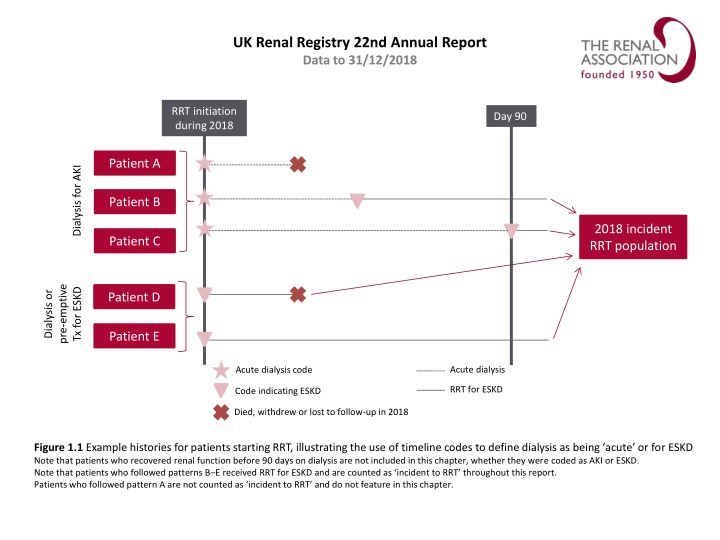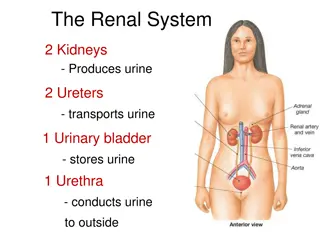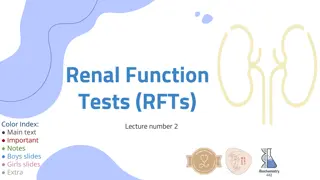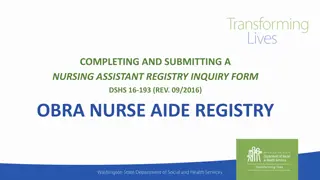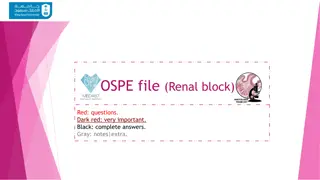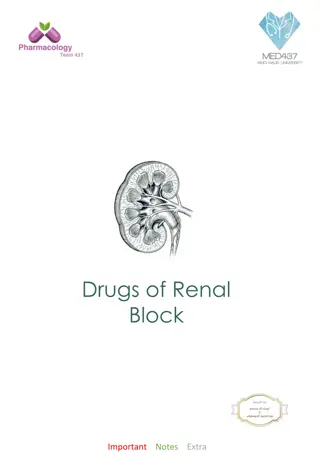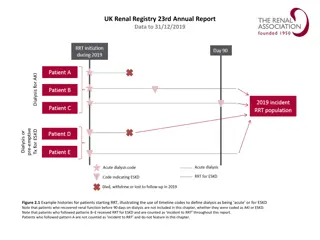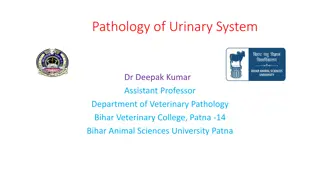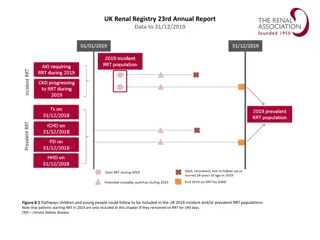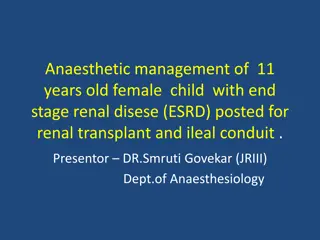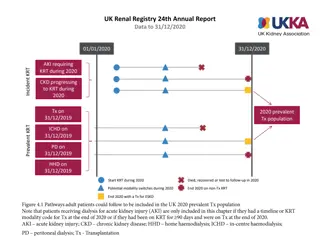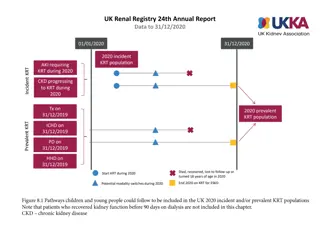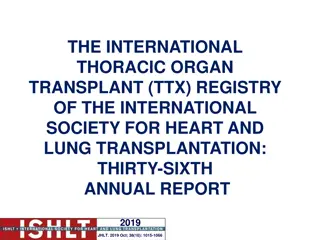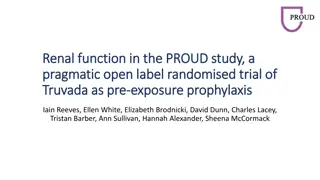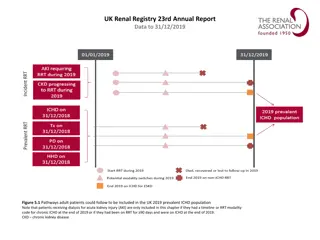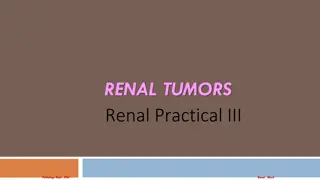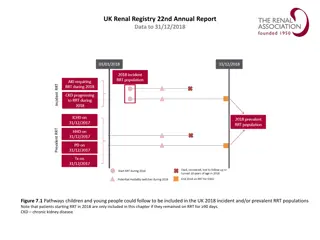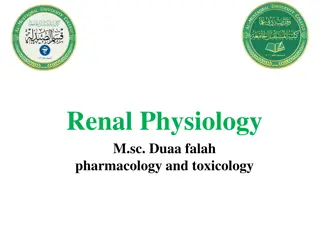UK Renal Registry 22nd Annual Report Data (2018)
The UK Renal Registry's 22nd Annual Report Data to 31/12/2018 provides detailed insights into various aspects of renal replacement therapy (RRT) initiation, incidence rates, primary renal diseases, RRT modalities, and more. The report includes figures illustrating RRT initiation patterns, adult RRT incidence rates by country and age group, incidence rates by age group and sex, changes in primary renal diseases, RRT modality at one year, and percentages of incident adult RRT patients presenting late to a nephrologist.
Download Presentation

Please find below an Image/Link to download the presentation.
The content on the website is provided AS IS for your information and personal use only. It may not be sold, licensed, or shared on other websites without obtaining consent from the author.If you encounter any issues during the download, it is possible that the publisher has removed the file from their server.
You are allowed to download the files provided on this website for personal or commercial use, subject to the condition that they are used lawfully. All files are the property of their respective owners.
The content on the website is provided AS IS for your information and personal use only. It may not be sold, licensed, or shared on other websites without obtaining consent from the author.
E N D
Presentation Transcript
UK Renal Registry 22nd Annual Report Data to 31/12/2018 RRT initiation during 2018 Day 90 Patient A Dialysis for AKI Patient B 2018 incident RRT population Patient C pre-emptive Dialysis or Tx for ESKD Patient D Patient E Acute dialysis Acute dialysis code RRT for ESKD Code indicating ESKD Died, withdrew or lost to follow-up in 2018 Figure 1.1 Example histories for patients starting RRT, illustrating the use of timeline codes to define dialysis as being acute or for ESKD Note that patients who recovered renal function before 90 days on dialysis are not included in this chapter, whether they were coded as AKI or ESKD. Note that patients who followed patterns B E received RRT for ESKD and are counted as incident to RRT throughout this report. Patients who followed pattern A are not counted as incident to RRT and do not feature in this chapter.
UK Renal Registry 22nd Annual Report Data to 31/12/2018 Figure 1.2 Adult RRT incidence rates by country between 2008 and 2018 Country was determined by patient postcode. Rates appear higher than in previous reports, because from this year those <18 years were excluded from estimated populations. pmp per million population
UK Renal Registry 22nd Annual Report Data to 31/12/2018 Figure 1.3 Adult RRT incidence rates by age group between 2008 and 2018 pmp per million population
UK Renal Registry 22nd Annual Report Data to 31/12/2018 Figure 1.4 Incidence rates for adult patients starting RRT in 2018 by age group and sex pmp per million population
UK Renal Registry 22nd Annual Report Data to 31/12/2018 Figure 1.5 Change in primary renal disease (PRD) of adult patients incident to RRT from 2009 to 2018
UK Renal Registry 22nd Annual Report Data to 31/12/2018 Figure 1.6 RRT modality at 1 year for incident adult RRT patients who started RRT in 2017 by centre Number of patients in a centre in brackets. Out moved out of a centre but did not reappear in another centre; Rec recovered kidney function; Stop treatment withdrawal
UK Renal Registry 22nd Annual Report Data to 31/12/2018 Figure 1.7 Percentage of incident adult RRT patients presenting late (<90 days) to a nephrologist (2017 2018 2 year cohort) Scottish data on referral were not used to calculate the UK mean because of a different definition (see appendix A). CI confidence interval
UK Renal Registry 22nd Annual Report Data to 31/12/2018 Figure 1.8 Geometric mean estimated glomerular filtration rates (eGFR) for adult patients incident to RRT in 2018 by age group and start modality CI confidence interval
UK Renal Registry 22nd Annual Report Data to 31/12/2018 Figure 1.9 Percentage of adult patients incident to RRT in 2018 with haemoglobin (Hb) 100 g/L at start of RRT treatment by centre. CI confidence interval
UK Renal Registry 22nd Annual Report Data to 31/12/2018 Figure 1.10 Distribution of haemoglobin (Hb) in incident adult RRT patients by year of start between 2009 and 2018
UK Renal Registry 22nd Annual Report Data to 31/12/2018 Figure 1.11 Percentage of adult patients incident to RRT in 2018 with adjusted calcium (Ca) above the normal range (>2.5 mmol/L) by centre CI confidence interval
UK Renal Registry 22nd Annual Report Data to 31/12/2018 Figure 1.12 Dialysis access used for adult patients incident to RRT in 2018 by age group (2018 Multisite Dialysis Access Audit) AVF arteriovenous fistula; AVG arteriovenous graft; NTL non-tunnelled line; TL tunnelled line
UK Renal Registry 22nd Annual Report Data to 31/12/2018 Figure 1.13 Dialysis access used for adult patients incident to RRT in 2018 by primary renal disease (2018 Multisite Dialysis Access Audit) AVF arteriovenous fistula; AVG arteriovenous graft; NTL non-tunnelled line; TL tunnelled line
UK Renal Registry 22nd Annual Report Data to 31/12/2018 Figure 1.14 Dialysis access used for adult patients incident to RRT in 2018 by presentation time (2018 Multisite Dialysis Access Audit) AVF arteriovenous fistula; AVG arteriovenous graft; NTL non-tunnelled line; TL tunnelled line
UK Renal Registry 22nd Annual Report Data to 31/12/2018 Figure 1.15 Dialysis access used for adult patients incident to dialysis in 2018 by surgical assessment time (2018 Multisite Dialysis Access Audit) AVF arteriovenous fistula; AVG arteriovenous graft; NTL non-tunnelled line; TL tunnelled line
UK Renal Registry 22nd Annual Report Data to 31/12/2018 Figure 1.16 First dialysis access used for adult patients incident to RRT in 2018 by centre (2018 Multisite Dialysis Access Audit) Number of incident patients on RRT in a centre in brackets (centres with <70% access data for the incident RRT population were excluded). Centres are ordered by decreasing use of lines. AVF arteriovenous fistula; AVG arteriovenous graft; NTL non-tunnelled line; TL tunnelled line
UK Renal Registry 22nd Annual Report Data to 31/12/2018 Figure 1.17 Percentage of adult patients incident to dialysis in 2018 who started dialysis using either an arteriovenous fistula (AVF) or an arteriovenous graft (AVG) by centre (2018 Multisite Dialysis Access Audit) Numbers in brackets represent the number of patients with data in each centre rather than missing data. CI confidence interval
UK Renal Registry 22nd Annual Report Data to 31/12/2018 Figure 1.18 PD catheter insertion technique for adult patients incident to PD in 2018 by centre (2018 Multisite Dialysis Access Audit) Centres with <10 incident PD patients were excluded. Number of incident patients on PD in a centre in brackets. Centres are ordered by decreasing use of non-surgical PD insertion technique.
UK Renal Registry 22nd Annual Report Data to 31/12/2018 Figure 1.19 PD catheter insertion technique for adult patients incident to PD in 2018 by presentation time (2018 Multisite Dialysis Access Audit)
UK Renal Registry 22nd Annual Report Data to 31/12/2018 Figure 1.20 PD catheter insertion technique for adult patients incident to PD in 2018 by body mass index (2018 Multisite Dialysis Access Audit)
UK Renal Registry 22nd Annual Report Data to 31/12/2018 Figure 1.21 Peritonitis within 2 weeks of catheter insertion for adult patients incident to PD in 2017 and 2018 (2017 and 2018 Multisite Dialysis Access Audits)
UK Renal Registry 22nd Annual Report Data to 31/12/2018 Figure 1.22 Percentage of PD catheter failures within 1 year of first ever PD session for adult patients incident to PD in 2017 (2018 Multisite Dialysis Access Audit) Centres with follow-up data for <10 PD patients were excluded.
UK Renal Registry 22nd Annual Report Data to 31/12/2018 Figure 1.23 Percentage of incident adult dialysis patients experiencing failure of first access within 3 months by type of first access (2017 and 2018 Multisite Dialysis Access Audits) AVF arteriovenous fistula; AVG arteriovenous graft; CI confidence interval; TL tunnelled line
UK Renal Registry 22nd Annual Report Data to 31/12/2018 Figure 1.24 Cause of PD catheter access failure within 1 year of first ever PD session for adult patients incident to PD in 2017 (2018 Multisite Dialysis Access Audit)
UK Renal Registry 22nd Annual Report Data to 31/12/2018 Figure 1.25 1 year after 90 days survival (adjusted to age 60 years) of incident adult RRT patients by start modality between 2008 and 2017 CI confidence interval
UK Renal Registry 22nd Annual Report Data to 31/12/2018 Figure 1.26 90 days, 1 year and 1 year after 90 days survival of incident adult RRT patients by age group (2017 cohort) CI confidence interval
UK Renal Registry 22nd Annual Report Data to 31/12/2018 Figure 1.27 1 year after 90 days death rate per 1,000 incident RRT adult patient years by age group and country (2014 2017 4 year cohort)
UK Renal Registry 22nd Annual Report Data to 31/12/2018 Figure 1.28 Survival (unadjusted) of incident adult RRT patients from day 0 by age group (2008 2017 10 year cohort)
UK Renal Registry 22nd Annual Report Data to 31/12/2018 Figure 1.29 Monthly hazard of death (unadjusted) of incident adult RRT patients from day 0 to 1 year by age group (2008 2017 10 year cohort)
UK Renal Registry 22nd Annual Report Data to 31/12/2018 Figure 1.30 6 monthly hazard of death (unadjusted) of incident adult RRT patients from day 0 to 10 years by age group (2008 2017 10 year cohort)
UK Renal Registry 22nd Annual Report Data to 31/12/2018 Figure 1.31 1 year after 90 days survival (adjusted to age 60 years) of incident adult RRT patients by centre (2014 2017 4 year cohort)
UK Renal Registry 22nd Annual Report Data to 31/12/2018 Figure 1.32 1 year after 90 days survival (adjusted to age 60 years, male and median comorbidity score) of incident adult RRT patients by centre (2014 2017 4 year cohort)
